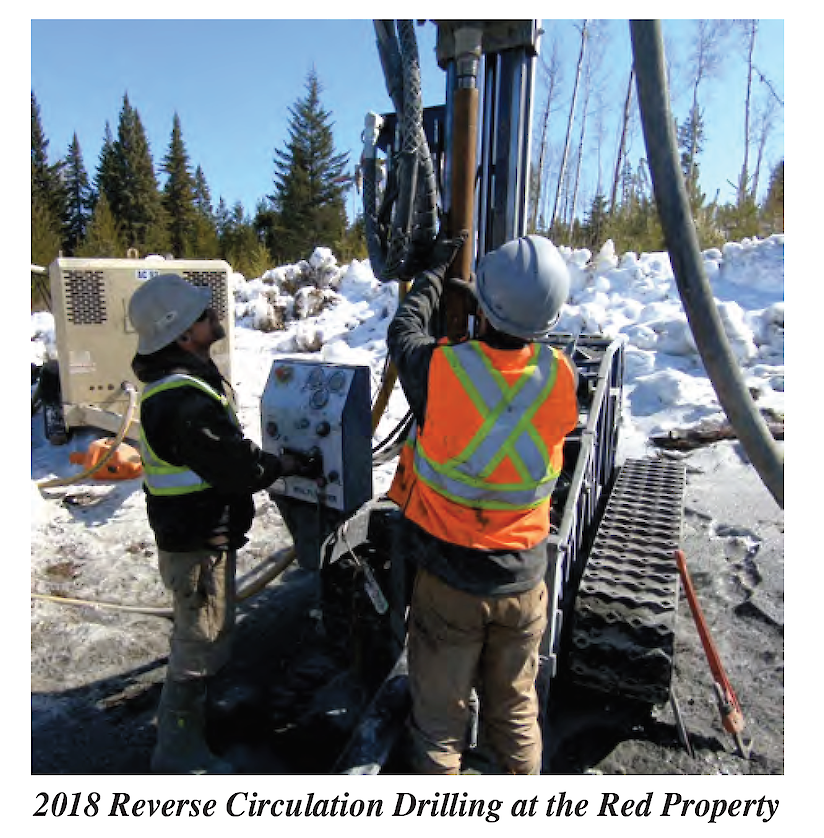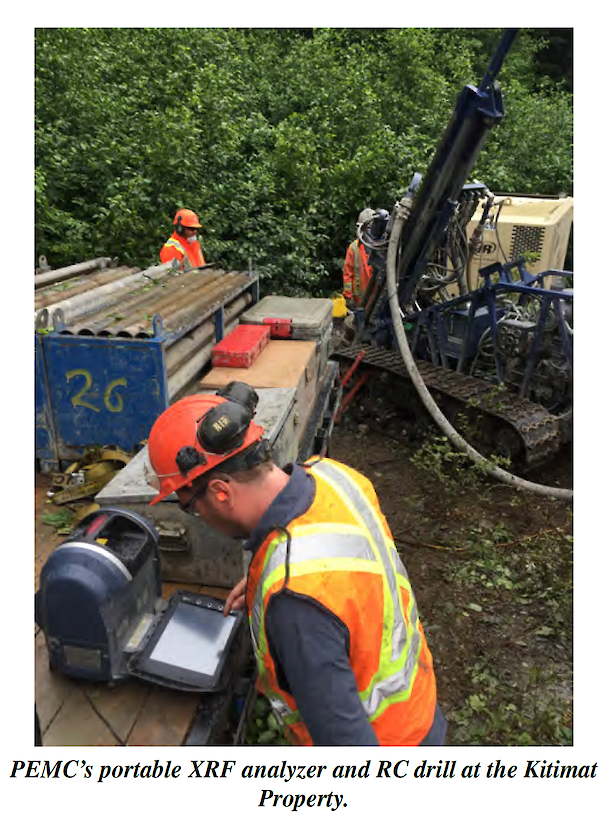
PEMC began the 2018 exploration season at the Red JV Property, located 56 km southeast of Williams Lake in southcentral British Columbia. The proximity of the property to the communities of 100 Mile House and Williams Lake made it an ideal location to begin drilling with the company’s recently acquired reverse circulation ("RC") drill. In addition, the presence of numerous logging roads and flat topography made moving and setting the drill up straightforward. The target area consisted of an area where historical Induced Polarization ("IP") surveys identified an area of anomalous chargeability and copper-gold soil geochemistry. A total of eight holes were completed over the target area, however results from drilling suggested that the anomalous chargeability response in this area was most likely due to the presence of graphite within a volcano-sedimentary unit. The next project tested with the RC drill was the Wildcat Property, located approximately 10 km to the southwest of Centerra Gold’s Mt. Milligan Mine. Three target areas were tested where anomalous IP chargeability signatures were identified. Although anomalous copper was encountered, the XRF results showed intervals were not of significant grade and width for laboratory analysis. The Company will be evaluating remaining targets over the next several weeks. In both cases PEMC was rapidly and cost effectively able to test exploration targets with its RC drill. RC drilling has commenced at the Kitimat Property testing the company’s third property of 2018. Two target areas have been prioritized for RC drill testing during this phase of drilling. The Company is looking to expand upon historically drilled zones by testing targets potentially associated with the potassic core of a copper-gold porphyry system. 2018 exploration on the Kitimat Property
Following RC drilling at the Kitimat Property, the next projects for PEMC to test are those located in the Toodoggone district in north-central British Columbia. The Toodoggone District is seeing renewed exploration interest this year with exploration programs being conducted by HudBay Minerals, Freeport-McMoRan and several other explorers. Traditionally a district where epithermal gold and silver deposits were the focus of exploration efforts, recent advances in understanding of exploration models in this area suggest there is greater potential for porphyry copper deposits at lower elevations in the district. The Nub East Property is ideally suited for RC drilling and its location in a valley bottom at low elevations is conducive to porphyry copper potential. The 2018 exploration target for PEMC is an anomalous magnetic signature identified from PEMC’s 2017 airborne magnetic survey. The Nub East Property is entirely surrounded by the Joy Project which is currently under option from Amarc Resources by HudBay Minerals. HudBay Minerals has confirmed funding of $3.15 million for exploration at the Joy Project in 2018 which will consist of IP surveys and diamond drilling. The Nub East exploration target is derived from an analogous concept to HudBay’s "Finlay Magnetic Corridor", where deposit-scale magnetic anomalies along a favourable trend have been outlined and prioritized for drill testing. PEMC has conducted several exploration programs on the Copper King Property since acquisition by staking in 2014 and has identified a priority drill target in a valley in the northern portion of the property for RC drill testing during 2018. The target consists of a pronounced magnetic low coincident with a IP chargeability high which is interpreted as a phyllic alteration halo above a potential copper-gold porphyry system. Historical drilling in 1976 intersected anomalous copper on the margin of this target, and PEMC looks forward to testing the "guts" of this porphyry target.
Partner Funded Exploration
ML Gold has mobilized drill crews to the Stars Property and will to continue to advance the project with diamond drilling (see ML Gold Corp. press release dated July 12, 2018). The upcoming drill program will focus on "Zone 4 Area" where initial diamond drilling results from January 2018 intersected copper mineralization up to 204 metres grading 0.45% Cu in drill hole DD18SS004. Following the initial four-hole drill program, and a property-wide airborne magnetic survey, ML Gold recommenced diamond drilling in April and completed an additional four holes targeting newly identified magnetic anomalies from the airborne survey.The two areas prioritized for drilling included the previously identified Zone 4 in addition to the Central Area where several circular magnetic anomalies were identified within a broad magnetic low. Mineralization encountered to date consists of chalcopyrite +/- molybdenum associated with localized potassic alteration. Mineralized zones are associated with a broader chlorite +/- sericite alteration halo, suggesting the potential for a hydrothermal system of significant size.
The Stars Property represents a good example of a previously unknown porphyry system in BC that is obscured by glacial overburden, which forms the premise of much of PEMC’s targeting approach. PEMC looks forward to this next phase of partner-funded drilling at the Stars Property. Under the terms of the agreement between ML Gold and PEMC, PEMC will maintain a 20% carried interest to a Pre-Feasibility Study, if ML Gold exercises their earn-in option. Stars Property target areas with airborne magnetics
Recent Property Acquisitions
In April of 2018, PEMC staked an additional three properties in north-central British Columbia and one in south-central British Columbia. The Moffat Property, located 56 km to the east of Williams Lake in south-central British Columbia covers 4,090 hectares and lies immediately to the south of Consolidated Woodjam Copper’s Woodjam South Project, which has an inferred mineral resource at the Southeast Zone of 227.5 million tonnes at 0.31% copper for 1.54 billion pounds of copper. Following acquisition of the Moffat Property, an airborne magnetic survey was flown over the entire property. The survey was flown using a "stinger" magnetometer attached directly to the helicopter rather than a "towed array" thats hangs beneath a helicopter. This configuration, provided by Peter E. Walcott & Associates Ltd. geophysical services company allows the helicopter to travel at greater speeds, resulting in reduced survey times and associated costs. The 2018 airborne survey was successful in outlining a target area of significant size that now consists of anomalous IP chargeability coincident with a complex magnetic low anomaly which is flanked by historical drilling that intersected anomalous copper-gold in drilling. "Stinger" magnetometer mounted to helicopter In the Bulkley district of west-central British Columbia, PEMC staked three properties: the Bulkley, Bull’s Eye and Wasp properties totaling 5,070 hectares. These properties fall within PEMC’s Bulkley Initiative which is targeting Eocene to Cretaceous aged copper porphyry deposits. Although much exploration in British Columbia is focused on Jurassic to Triassic aged porphyry copper deposits, PEMC believes that Eocene to Cretaceous aged copper deposits are under-explored in this region.

Exploration 101 - XRF Analysis
An X-ray fluorescence ("XRF") spectrometer is an instrument used for analysis of rocks, minerals, sediments and soils. XRF analysis works by using an X-ray beam to excite fluorescent radiation from the sample and it does not result in the destruction of the sample. PEMC’s analyzer is equipped with an industrial grade X-ray Fluorescence analyzer high resolution detector system. Once a homogenized sample is prepared in a small cup and placed in the XRF analyzer, a sample time of 90 seconds is selected and the cover is closed. The resulting analysis reports results for P, S, C, K, Ca, Ti, V, Cr, Mn, Fe, Co, Ni, Cu, Zn, As, Se, Rb, Sr, Y, Zr, Mo, Rh, Pd, Ag, Cd, Sn, Sb, W, Pt, Au, Hg, Pb, Bi, Th, and U using a Tantalum X-ray Tube. The most obvious benefit to using an XRF analyzer is not having to send all samples to a laboratory for analysis where results may take several weeks to receive at a cost of approximately $30 per sample. This results in considerable cost savings and the ability to immediately receive preliminary results by screening samples on-site and in real-time. In addition to soil and sediment sampling XRF analysis is well suited for RC drilling due to the homogenized nature of the sample. By combining real-time XRF analysis with RC drilling PEMC is able to save on unnecessary laboratory costs and is able to gather information that will aid in real-time targeting with the RC drill. PEMC’s portable XRF analyzer and RC drill at the Kitimat Property.
TSX-V:PEMC
m pemcorp.ca
T (604) 356-6246
B info@pemcorp.ca
